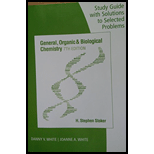
(a)
Interpretation:
Completion of the following table of information about selected ionic compounds.
Concept Introduction:
Chemical formulas and names for ionic compounds containing polyatomic ions:
Ionic compounds containing positive and negative charges present must add to zero.
If more than one polyatomic ion is present in a compound, the chemical formula can be written as a polyatomic ion is enclose in parentheses and a subscript, placed outside of the parentheses. Example-
Sometimes same element is present in two different locations. For example,
(a)
Answer to Problem 4.123EP
The completed table is as follows:
Explanation of Solution
The given name of the compound has
The dissociation of
From the above reaction,
Barium is a metal cation and bromide is a nonmetal anion.
Hence, the compound name is Barium bromide.
Therefore, the completed table is shown below:
(b)
Interpretation:
Completion of the following table of information about selected ionic compounds.
Concept Introduction:
Chemical formulas and names for ionic compounds containing polyatomic ions:
Ionic compounds containing positive and negative charges present must add to zero.
If more than one polyatomic ion is present in a compound, the chemical formula can be written as a polyatomic ion is enclose in parentheses and a subscript, placed outside of the parentheses. Example-
Sometimes same element is present in two different locations. For example,
(b)
Answer to Problem 4.123EP
The completed table is as follows:
Explanation of Solution
The ionic compound has positive zinc ion
The name of the compound
Therefore, the completed table is shown below:
(c)
Interpretation:
Completion of the following table of information about selected ionic compounds.
Concept Introduction:
Chemical formulas and names for ionic compounds containing polyatomic ions:
Ionic compounds containing positive and negative charges present must add to zero.
If more than one polyatomic ion is present in a compound, the chemical formula can be written as a polyatomic ion is enclose in parentheses and a subscript, placed outside of the parentheses. Example-
Sometimes same element is present in two different locations. For example,
(c)
Answer to Problem 4.123EP
The completed table is as follows.
Explanation of Solution
The given compound name has Iron (III) carbonate.
It indicates compound has positive ferric ion
Therefore, the completed table is shown below:
(d)
Interpretation:
Completion of the following table of information about selected ionic compounds.
Concept Introduction:
Chemical formulas and names for ionic compounds containing polyatomic ions:
Ionic compounds containing positive and negative charges present must add to zero.
If more than one polyatomic ion is present in a compound, the chemical formula can be written as a polyatomic ion is enclose in parentheses and a subscript, placed outside of the parentheses. Example-
Sometimes same element is present in two different locations. For example,
(d)
Answer to Problem 4.123EP
The completed table is as follows:
Explanation of Solution
The given name of the compound has
The dissociation of
From the above reaction,
Hence, the compound name is Lead(IV) oxide.
Therefore, the completed table is shown below:
Want to see more full solutions like this?
Chapter 4 Solutions
Study Guide with Selected Solutions for Stoker's General, Organic, and Biological Chemistry, 7th
- K Draw the starting structure that would lead to the major product shown under the provided conditions. Drawing 1. NaNH2 2. PhCH2Br 4 57°F Sunny Q Searcharrow_forward7 Draw the starting alkyl bromide that would produce this alkyne under these conditions. F Drawing 1. NaNH2, A 2. H3O+ £ 4 Temps to rise Tomorrow Q Search H2arrow_forward7 Comment on the general features of the predicted (extremely simplified) ¹H- NMR spectrum of lycopene that is provided below. 00 6 57 PPM 3 2 1 0arrow_forward
 General, Organic, and Biological ChemistryChemistryISBN:9781285853918Author:H. Stephen StokerPublisher:Cengage Learning
General, Organic, and Biological ChemistryChemistryISBN:9781285853918Author:H. Stephen StokerPublisher:Cengage Learning Living By Chemistry: First Edition TextbookChemistryISBN:9781559539418Author:Angelica StacyPublisher:MAC HIGHERChemistry: Matter and ChangeChemistryISBN:9780078746376Author:Dinah Zike, Laurel Dingrando, Nicholas Hainen, Cheryl WistromPublisher:Glencoe/McGraw-Hill School Pub Co
Living By Chemistry: First Edition TextbookChemistryISBN:9781559539418Author:Angelica StacyPublisher:MAC HIGHERChemistry: Matter and ChangeChemistryISBN:9780078746376Author:Dinah Zike, Laurel Dingrando, Nicholas Hainen, Cheryl WistromPublisher:Glencoe/McGraw-Hill School Pub Co World of Chemistry, 3rd editionChemistryISBN:9781133109655Author:Steven S. Zumdahl, Susan L. Zumdahl, Donald J. DeCostePublisher:Brooks / Cole / Cengage Learning
World of Chemistry, 3rd editionChemistryISBN:9781133109655Author:Steven S. Zumdahl, Susan L. Zumdahl, Donald J. DeCostePublisher:Brooks / Cole / Cengage Learning Introductory Chemistry: A FoundationChemistryISBN:9781337399425Author:Steven S. Zumdahl, Donald J. DeCostePublisher:Cengage Learning
Introductory Chemistry: A FoundationChemistryISBN:9781337399425Author:Steven S. Zumdahl, Donald J. DeCostePublisher:Cengage Learning ChemistryChemistryISBN:9781305957404Author:Steven S. Zumdahl, Susan A. Zumdahl, Donald J. DeCostePublisher:Cengage Learning
ChemistryChemistryISBN:9781305957404Author:Steven S. Zumdahl, Susan A. Zumdahl, Donald J. DeCostePublisher:Cengage Learning





